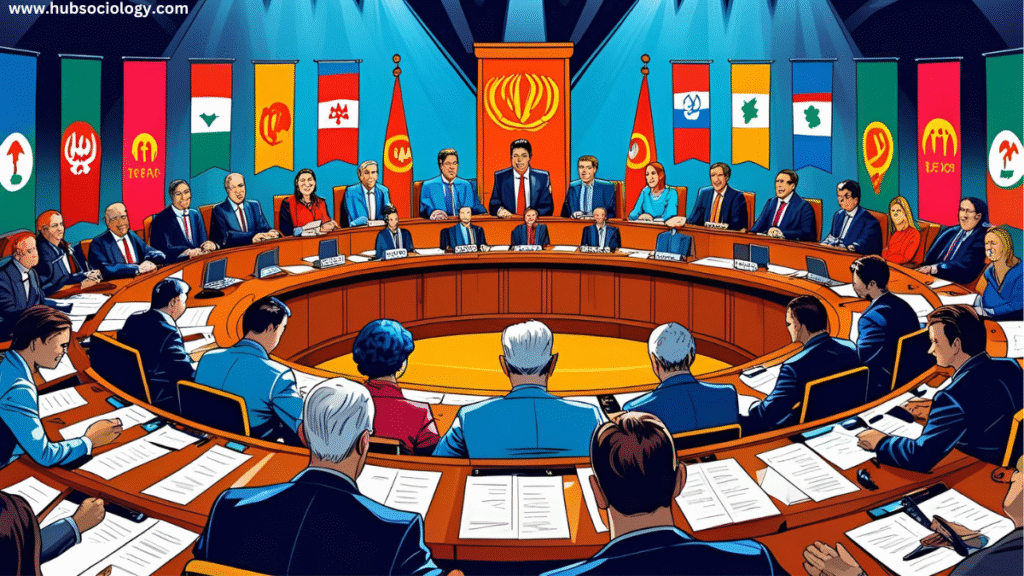Introduction
World-Systems Theory (WST), developed by sociologist Immanuel Wallerstein in the 1970s, offers a macro-sociological framework for understanding global inequalities and the historical development of the capitalist world economy. Unlike theories that examine development within single nations, WST analyzes the world as an interconnected system structured by power hierarchies, economic dependencies, and geopolitical dominance.
Asia’s complex and uneven development trajectory can be meaningfully interpreted through this lens. From colonial extraction to post-colonial industrial growth, and from emerging superpowers to marginalized peripheries, Asia encapsulates the dynamics of the core-periphery-semi-periphery model proposed by WST. This article explores the sociological relevance of WST in understanding Asian development, emphasizing how global structural relations shape regional growth, inequality, and resistance.

Understanding World-Systems Theory: A Sociological Overview
World-Systems Theory views the world economy as a single capitalist system that emerged in the 16th century. It consists of:
- Core Countries: Economically advanced, technologically innovative, and politically dominant nations (e.g., USA, UK, Germany).
- Peripheral Countries: Less developed, often dependent on core nations, supplying raw materials and labor (e.g., much of Sub-Saharan Africa).
- Semi-Peripheral Countries: Intermediate positions—some industrial capacity, but still dependent (e.g., Brazil, India, China historically).
WST critiques modernization theory, which assumes linear development from “traditional” to “modern” societies, and dependency theory, which focuses only on bilateral exploitation. Instead, WST emphasizes systemic global relations that perpetuate inequality.
Asia in the Global Capitalist System
Asia’s development must be understood not in isolation but as part of evolving global structures. Historically, various regions in Asia have been positioned differently within the world system:

1. Colonial Incorporation of Asia into the World-System
European colonization forcibly integrated much of Asia into the global capitalist economy. India, Southeast Asia, and China became peripheries, supplying raw materials like cotton, tea, rubber, and spices to core industrial economies. Colonial states controlled local production, dismantled traditional industries (e.g., Indian textiles), and imposed economic structures favoring extraction.
This peripheralization of Asia was not a natural outcome of backwardness, but a structural imposition through coercion, trade monopolies, and imperial policy. The colonized regions became economically dependent and socially dislocated, with weak national capital and industrial capacity.
2. Post-Colonial Nation-Building and Semi-Peripheral Ascent
After World War II and the wave of decolonization, many Asian countries sought development via state-led industrialization. Some countries, like India, Indonesia, and Malaysia, adopted protectionist and planned economic models, while others aligned with capitalist (e.g., South Korea, Taiwan) or socialist blocs (e.g., China, Vietnam).
According to WST, many of these countries transitioned to semi-peripheral status. For instance:
- South Korea and Taiwan became successful semi-peripheries with advanced export-oriented economies, moving closer to core status.
- India, despite industrial progress, remained semi-peripheral due to internal inequalities, dependency on Western technology, and structural poverty.
- China, post-1978 reforms, transitioned rapidly from a socialist periphery to a dynamic semi-periphery, and now arguably a rival core power.
The Role of Global Capital and Labor Flows
World-Systems Theory highlights how core countries outsource labor-intensive production to semi-peripheral and peripheral zones, preserving their technological dominance and capital accumulation. Asia became central to this logic through global value chains and foreign direct investment (FDI).
- Manufacturing Zones: Countries like Vietnam, Bangladesh, and the Philippines became hubs for garment, electronics, and low-cost assembly industries. These zones reflect peripheral characteristics: low wages, labor exploitation, and environmental degradation.
- Service Economies: India’s rise as an IT and service outsourcing center reflects semi-peripheral dynamics—skilled labor integrated into global markets, yet heavily reliant on foreign clients and vulnerable to capital shifts.
- Labor Migration: Millions of Asian workers migrate to the Gulf, East Asia, or the West, often facing harsh conditions. Migrant labor flows reproduce global class hierarchies within and beyond Asia.
These patterns reflect how Asian development is structurally embedded in the demands and strategies of global capital rather than purely internal policy choices.
Uneven Development and Internal Stratification
World-Systems Theory allows a sociological understanding of intra-regional inequality. Within Asia, not all countries or regions have benefited equally from integration into global capitalism. For example:
- China’s coastal cities like Shanghai and Shenzhen are highly developed, while western provinces remain economically backward—mirroring core-periphery patterns within a single nation.
- India has a booming tech sector, yet vast rural and tribal regions suffer from deprivation, agrarian crises, and infrastructural neglect.
Such disparities are a hallmark of uneven development, where capital concentrates geographically, creating zones of affluence and abandonment. Sociologically, this generates class stratification, urban migration, and social unrest.
Geopolitics, Resistance, and the Changing Global Order
While WST has been critiqued for determinism, it acknowledges the role of social movements, state strategy, and geopolitical shifts in altering world-systemic positions.
1. Asian Geopolitical Strategies
- China’s Belt and Road Initiative (BRI) aims to create infrastructure and trade networks across Asia, Africa, and Europe—challenging Western economic dominance and expanding China’s influence.
- India’s “Act East” policy and Japan’s strategic aid reflect regional ambitions to move up the global hierarchy.
These indicate that semi-peripheral powers are not passive victims but strategic actors in world-systems dynamics.
2. Resistance Movements
From peasant revolts in India to labor strikes in Bangladesh’s garment sector and pro-democracy movements in Hong Kong, local resistance reflects contestation against exploitation and exclusion. These movements often challenge not just national governments but global economic structures.
Sociologically, these struggles reveal how class, gender, caste, and ethnicity intersect with global capitalism. For instance:
- Women garment workers in Southeast Asia face low wages and sexual harassment, yet are central to global fashion industries.
- Indigenous and tribal communities resist land grabs for mining or mega-projects driven by global demand.
World-Systems Theory in the 21st Century: Relevance and Critiques
While WST remains influential, it has evolved and faced critiques:
Critiques:
- Eurocentrism: Critics argue WST downplays Asian agency and frames development only in relation to the West.
- Neglect of Culture and Identity: WST is seen as overly economistic, underplaying the role of religion, ideology, and nationalism.
- Environmental Concerns: Early WST ignored ecological degradation; however, newer works incorporate ecological world-systems analysis.
Continued Relevance:
Despite critiques, WST continues to offer key insights:
- It highlights structural inequality, showing how poor countries are not underdeveloped by chance but are systemically underdeveloped.
- It explains why development is uneven, why some Asian nations rise while others lag, and how global markets, debt, and trade rules influence domestic outcomes.
- It encourages a global historical perspective, helping scholars see Asia not as a region to be “developed” but as a dynamic player within a changing global order.
Conclusion
World-Systems Theory remains a powerful sociological tool to understand Asian development within global capitalism. It enables us to see beyond national narratives and consider the global structures of power, economy, and inequality that shape Asia’s past and present.

From colonial peripheries to emerging cores, from exploited workers to rising middle classes, and from dependency to resistance, Asia reflects the contradictions and complexities of world-systems dynamics. As Asia continues to redefine its role in the 21st century, WST reminds us that development is not merely a domestic issue—but a global one, rooted in centuries of interconnected history.
Do you like this this Article ? You Can follow as on :-
Facebook – https://www.facebook.com/hubsociology
Whatsapp Channel – https://whatsapp.com/channel/0029Vb6D8vGKWEKpJpu5QP0O
Gmail – hubsociology@gmail.com
Topic Related Questions
5 Marks Questions (Short Answer – Conceptual Understanding)
- What is World-Systems Theory in sociology?
- Define the terms core, semi-periphery, and periphery in the context of global development.
- How does World-Systems Theory differ from modernization theory?
- Give two examples of Asian countries classified as semi-peripheral according to World-Systems Theory.
- Briefly explain the impact of colonialism on Asian integration into the world-system.
- What role do global value chains play in Asia’s development?
- Mention two criticisms of World-Systems Theory.
- How does labor migration from Asia reflect world-system inequalities?
- State any two ways in which South Korea moved from a periphery to a semi-periphery/core.
- Define ‘uneven development’ as used in World-Systems Theory.
10 Marks Questions (Short Essay – Analytical Insight)
- Discuss the relevance of World-Systems Theory in analyzing post-colonial Asian development.
- How does World-Systems Theory explain economic inequality among Asian nations?
- Explain with examples how global capitalism shapes labor relations in Asia.
- Evaluate the semi-peripheral status of India using the world-systems framework.
- Analyze China’s transformation in the world system from a peripheral to a potential core state.
- Discuss the limitations of World-Systems Theory in understanding the role of culture and nationalism in Asia.
- How do social movements in Asia challenge global and domestic inequalities under the world-system?
- Describe the structural impact of foreign direct investment (FDI) on peripheral Asian economies.
- Compare and contrast the developmental paths of two Asian countries using the core-periphery model.
- What are the sociological implications of the Belt and Road Initiative in world-systems terms?
15 Marks Questions (Long Essay – Critical Examination & Case Studies)
- Critically examine the application of World-Systems Theory to Asian development with appropriate examples.
- To what extent has globalization reinforced Asia’s position in the capitalist world-economy? Analyze using WST.
- Discuss how historical colonization and contemporary global capitalism have shaped uneven development in Asia.
- Evaluate the strengths and limitations of World-Systems Theory in explaining contemporary geopolitical shifts in Asia.
- Using case studies, discuss how World-Systems Theory explains internal inequalities within large Asian countries like India or China.
- “Asia’s development is structured by its position in the world-system.” Discuss this statement with reference to production, labor, and trade patterns.
- Examine the impact of the global digital economy on semi-peripheral Asian nations from a world-systems perspective.
- How can the rise of China and India reshape the core-periphery dynamics in the global order? Evaluate critically.
- Assess the relevance of World-Systems Theory in understanding the environmental consequences of Asia’s development.
- Analyze the sociological impact of export-oriented industrialization in Southeast Asia using WST concepts.
